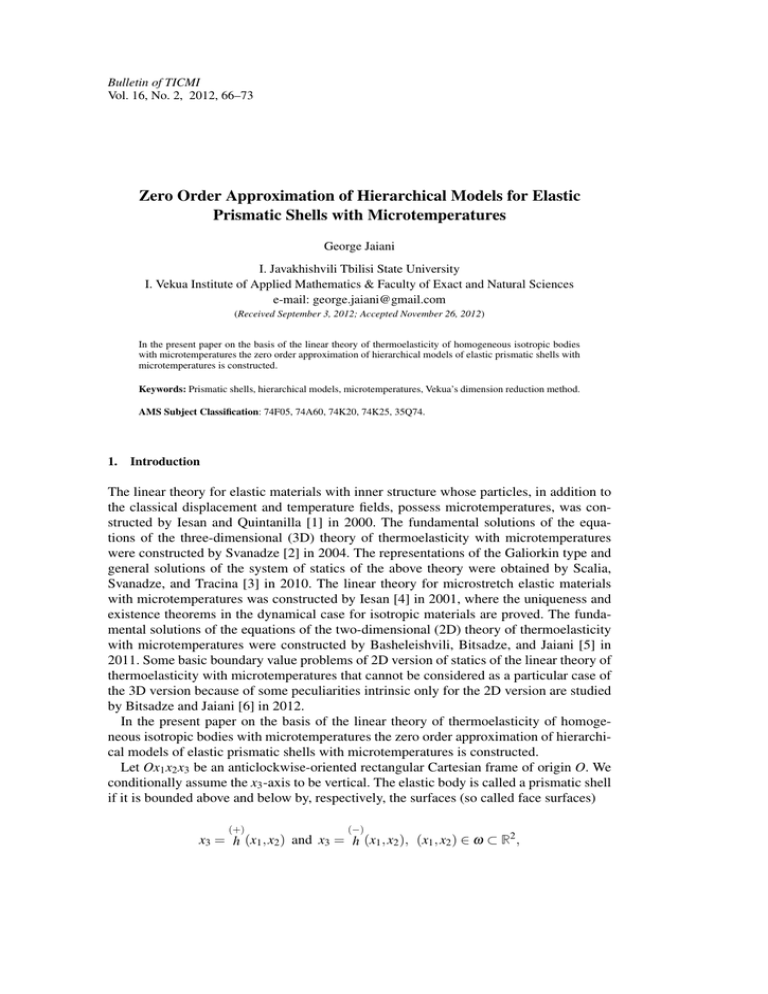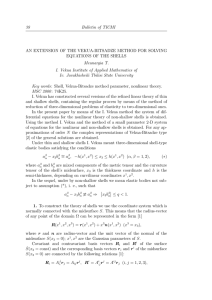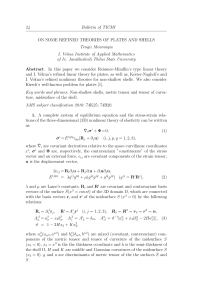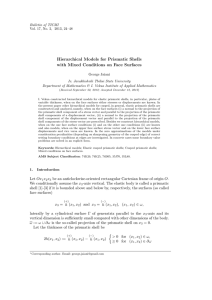Zero Order Approximation of Hierarchical Models for Elastic
advertisement

Bulletin of TICMI
Vol. 16, No. 2, 2012, 66–73
Zero Order Approximation of Hierarchical Models for Elastic
Prismatic Shells with Microtemperatures
George Jaiani
I. Javakhishvili Tbilisi State University
I. Vekua Institute of Applied Mathematics & Faculty of Exact and Natural Sciences
e-mail: george.jaiani@gmail.com
(Received September 3, 2012; Accepted November 26, 2012)
In the present paper on the basis of the linear theory of thermoelasticity of homogeneous isotropic bodies
with microtemperatures the zero order approximation of hierarchical models of elastic prismatic shells with
microtemperatures is constructed.
Keywords: Prismatic shells, hierarchical models, microtemperatures, Vekua’s dimension reduction method.
AMS Subject Classification: 74F05, 74A60, 74K20, 74K25, 35Q74.
1. Introduction
The linear theory for elastic materials with inner structure whose particles, in addition to
the classical displacement and temperature fields, possess microtemperatures, was constructed by Iesan and Quintanilla [1] in 2000. The fundamental solutions of the equations of the three-dimensional (3D) theory of thermoelasticity with microtemperatures
were constructed by Svanadze [2] in 2004. The representations of the Galiorkin type and
general solutions of the system of statics of the above theory were obtained by Scalia,
Svanadze, and Tracina [3] in 2010. The linear theory for microstretch elastic materials
with microtemperatures was constructed by Iesan [4] in 2001, where the uniqueness and
existence theorems in the dynamical case for isotropic materials are proved. The fundamental solutions of the equations of the two-dimensional (2D) theory of thermoelasticity
with microtemperatures were constructed by Basheleishvili, Bitsadze, and Jaiani [5] in
2011. Some basic boundary value problems of 2D version of statics of the linear theory of
thermoelasticity with microtemperatures that cannot be considered as a particular case of
the 3D version because of some peculiarities intrinsic only for the 2D version are studied
by Bitsadze and Jaiani [6] in 2012.
In the present paper on the basis of the linear theory of thermoelasticity of homogeneous isotropic bodies with microtemperatures the zero order approximation of hierarchical models of elastic prismatic shells with microtemperatures is constructed.
Let Ox1 x2 x3 be an anticlockwise-oriented rectangular Cartesian frame of origin O. We
conditionally assume the x3 -axis to be vertical. The elastic body is called a prismatic shell
if it is bounded above and below by, respectively, the surfaces (so called face surfaces)
(+)
(−)
x3 = h (x1 , x2 ) and x3 = h (x1 , x2 ), (x1 , x2 ) ∈ ω ⊂ R2 ,
Vol. 16, No. 2, 2012
67
laterally by a cylindrical surface Γ of generatrix parallel to the x3 -axis and its vertical dimension is sufficiently small compared with other dimensions of the body. In other words,
the 3D elastic prismatic shell-like body occupies a bounded region Ω with boundary ∂ Ω,
which is defined as:
}
Ω := (x1 , x2 , x3 ) ∈ R : (x1 , x2 ) ∈ ω , h (x1 , x2 ) < x3 < h (x1 , x2 ) ,
{
(+)
(−)
3
(1)
where ω := ω ∪ ∂ ω is the so-called projection of the prismatic shell Ω := Ω∪ ∂ Ω γ := ∂ ω
and ∂ Ω denote boundaries of ω and Ω, respectively; Rn is an n-dimensional Euclidian
space.
In what follows we assume that
(±)
2
h (x1 , x2 ) ∈ C (ω ) ∩C(ω ), 1
and
(+)
(−)
2h(x1 , x2 ) := h (x1 , x2 ) − h (x1 , x2 )
{
> 0 for (x1 , x2 ) ∈ ω ,
≥ 0 for (x1 , x2 ) ∈ ∂ ω
is the thickness of the prismatic shell Ω at the points (x1 , x2 ) ∈ ω ; max{2h} is essentially
less than the characteristic dimensions of ω ;
(+)
1
a := ,
h
(−)
h (x1 , x2 ) + h (x1 , x2 )
b :=
.
2h
2. Hierarchical Models
In order to construct hierarchical models we use Vekua’s dimension reduction method
[7], [8]. In what follows Xi j and ei j are the stress and strain tensors, respectively, ρ is the
reference mass density; Φi is the volume force; ui is the displacement vector; T is the
temperature measured from the constant absolute temperature T∗ > 0; η is the entropy
per unit mass; qi is the heat flux vector; S is the heat supply; εi is the first moment of
energy vector; q̃i j is the first heat flux moment vector; Qi is the mean heat flux vector; Mi
is the first heat source moment vector; λ , µ , β , ã, b̃, k, κs , (s = 1, 2, ..., 5) are constitutive
coefficients; δi j is the Kronecker delta, and wi is the microtemperature vector. Throughout
this article we use a superposed dot to denote partial differentiation with respect to time.
Moreover, repeated indices imply summation (Greek letters run from 1 to 2, and Latin
letters run from 1 to 3, unless otherwise stated), bar under one of the repeated indices
means that we do not sum.
By uir , Xi jr , ei jr , Φir , Tr , wir , Sr , Mir , Qir , qir , ηr , q̃i jr , εir we denote the r-th order mathematical moments (with respect to the Legendre polynomicals Pr ) of the corresponding
1C(ω ) denotes a class of functions continuous on ω ; C2 (ω ) denotes a class of twice continuously differentiable functions
with respect to the variables x1 and x2 with (x1 , x2 ) ∈ ω .
68
Bulletin of TICMI
quantities ui , Xi j , ei j , Φi , T , wi , S, Mi , Qi , qi , η , q̃i j , εi as defined below:
(
)
uir , Xi jr , ei jr , Φir , Tr , wir , Sr , Mir , Qir , qir , ηr , q̃i jr , εir (x1 , x2 ,t)
(+)
(x1 ,x2 )
h∫
(
)
ui , Xi j , ei j , Φi , T, wi , S, Mi , Qi , qi , η , q̃i j , εi (x1 , x2 , x3 ,t)
:=
(−)
h (x1 ,x2 )
×Pr (ax3 − b) dx3 , (x1 , x2 ) ∈ ω ⊂ R2 , i, j = 1, 2, 3.
(2)
Hierarchical models for elastic prismatic shells with microtemperatures are the mathematical models. Their constructing is based on the multiplication of the basic equations
of the linear theory of thermoelasticity with microtemperatures (see [1]):
The Motion Equations
..
Xi j,i + Φ j = ρ u j (x1 , x2 , x3 ,t),
(x1 , x2 , x3 ) ∈ Ω ⊂ R3 ,
t > t0 ,
j = 1, 2, 3;
(3)
The Balance of Energy
ρ T∗ η̇ = qi,i + ρ S;
(4)
The First Moment of Energy
ρ ε̇ j = qi j,i + q j − Q j + ρ M j ,
j = 1, 2, 3;
(5)
Generalized Hooke’s law (isotropic case)
Xi j = λ ell δi j + 2µ ei j − β T δi j , i, j = 1, 2, 3,
(6)
ρη = β ell + ãT,
(7)
ρε j = −b̃w j , j = 1, 2, 3,
q j = kT, j + κ1 w j , j = 1, 2, 3,
(8)
Q j = (κ1 − κ2 )w j + (k − κ3 )T, j , j = 1, 2, 3,
(9)
q̃i j = −κ4 wl,l δi j − κ5 wi, j − κ6 w j,i , i, j = 1, 2, 3;
(10)
The Kinematic Relations
1
ei j = (ui, j + u j,i ),
2
i, j = 1, 2, 3,
(11)
by Legendre polynomials Pr (ax3 − b) and then integration with respect to x3 within
(−)
(+)
the limits h (x1 , x2 ) and h (x1 , x2 ). Roughly speaking, assuming all the mathematical
Vol. 16, No. 2, 2012
69
moments for r > N to be equal to zero in the obtained relations, we get the Nth order
hierarchical model. We suppose that:
(i) Φi , S, and Mi are continuous on Ω × I, where I = [0, ∞[;
(ii) ρ is strictly positive;
(iii) the constitutive coefficients are constants.
The components of surface the traction Xn , the heat flux q, and the first heat flux moment
Λi at a regular point of ∂ Ω × I are defined by
Xni = X ji n j ,
q = qi ni ,
Λi = q̃ ji n j ,
(12)
respectively.
In the context of the linear theory, the Clausius-Duhem inequality has the form
qi T,i − T∗ q̃ ji wi, j − T0 (Qi − qi )wi ≥ 0.
(13)
Inequality (13) implies that
3κ4 + κ5 + κ6 ≥ 0,
κ6 − κ5 ≥ 0,
k ≥ 0,
κ6 + κ5 ≥ 0,
(14)
(κ1 + T0 κ3 )2 − 4T0 kκ2 ≤ 0.
We must adjoin boundary conditions and initial conditions to equations (3)-(11). Let us
consider the subsets Σr (r = 1, 2, ..., 6) of ∂ Ω such that Σ1 ∪Σ2 = Σ3 ∪Σ4 = Σ5 ∪Σ6 = ∂ Ω,
and Σ1 ∩ Σ2 = Σ3 ∩ Σ4 = Σ5 ∩ Σ6 = ∅.
In the case of the mixed boundary value problem the boundary conditions are
ui = ũi on Σ1 × I, i = 1, 2, 3,
(15)
X ji n j = X̃ni on Σ2 × I, i = 1, 2, 3,
(16)
wi = w̃i on Σ5 × I, i = 1, 2, 3,
(17)
T = Te on Σ3 × I, i = 1, 2, 3,
(18)
e i on Σ6 × I, i = 1, 2, 3,
q̃ ji n j = Λ
(19)
qi ni = q̃ on Σ4 × I, i = 1, 2, 3,
(20)
70
Bulletin of TICMI
where ũi , T̃ , w̃i , X̃ni , q̃, and Λ̃i are prescribed functions. The initial conditions are
u(x, 0) = u0 (x),
u̇(x, 0) = ∼u0 (x),
T (x, 0) = T 0 (x),
(21)
w(x, 0) = w0 (x), x ∈ B̄,
(22)
where u0 , v0 , T 0 , and w0 are given. We assume that: (i) ũi , T̃ , and w̃i are continuous functions; (ii) X̃ni , q̃, and Λ̃i are continuous in time and piecewise regular on Σ2 × I, Σ4 × I,
and Σ6 × I, respectively; (iii) u0i , v0i , T 0 , and w0i are continuous on Ω.
The mixed problem consists of finding the functions ui ∈ C2.1 (Ω×I), T ∈ C2.1 (Ω×I),
and wi ∈ C2.1 (Ω × I) on Ω × I that satisfy equations (3)-(11) on Ω × I, the boundary
conditions (15)-(20), and the initial conditions (21)-(22).
Substitution of equations (11) into (6) and then the obtained and (7)-(10) into equations
(3)-(5) yields the following system of linear partial differential equations for the fields
ui , T , and wi :
µ △ u + (λ + µ )grad div u − β grad T + Φ = ρ ü,
(23)
k △ T − β T∗ div u̇ + κ1 div w − cṪ = −ρ S,
(24)
κ6 △ w + (κ4 + κ5 )grad div w − κ3 grad T − κ2 w − b̃ẇ = ρ M,
(25)
where u := (u1 , u2 , u3 ), w := (w1 , w2 , w3 ), c := ãT∗ .
By constructing hierarchical models, on the upper and lower face surfaces temperatures,
(±)
(±)
stress-vectors X ji n j and first heat flux moment vectors q̃ ji n j are assumed to be known,
while on the upper and lower face surfaces the values of the displacement, microtemperature and heat flux vectors are calculated from their Fourier-Legendre–series expansions
on the segment
x3 ∈
]
[(−)
(+)
(x
,
x
)
(x
,
x
),
h 1 2 h 1 2 .
3. The N = 0 Approximation (Hierarchical Model)
Let
vi0 := h−1 ui0 ,
Wi0 := h−1 wi0 , i = 1, 2, 3.
Then the basic relations (constructed in the way pointed out in Section 2) of the zero
approximation for elastic isotropic prismatic shells with microtemperatures have the following form:
The Motion Equations
◦
Xα j0,α + X j = ρ ü j0 ,
j = 1, 2, 3;
(26)
Vol. 16, No. 2, 2012
71
The Balance of Energy
(+) (+)
(−) (−)
(+)
(−)
ρ T∗ η̇0 = qα 0,α − qα h,α + qα h,α + q3 − q3 + ρ S0 ;
(27)
The First Moment of Energy
0
ρ ε̇ j0 = −b̃ẇ j0 = q̃α j0,α + q̃ j + q j0 − Q j0 + ρ M jo , j = 1, 2, 3;
(28)
Generalized Hooke’s Law (isotropic case)
Xi j0 = λ δi j ell0 + 2µ ei j0 − β T0 δi j , i, j = 1, 2, 3;
(29)
0
0
1
eαβ 0 −
= (uα 0,β + uβ 0,α + bα 0 uβ 0 + bβ 0 uα 0 )
2
h,β
h,α
1
h
= (uα 0,β + uβ 0,α −
uβ 0 −
uα 0 ) = (vα 0,β + vβ 0,α ), α , β = 1, 2, (30)
2
h
h
2
0
h,α
h
1
1
e3α = eα 3 = (u30,α + bα 0 u30 ) = (u30,α −
u30 ) = v30,α , α = 1, 2,
2
2
h
2
e330 = 0,
i.e.,
h
ei j0 = (vi0, j + v j0,i ),
2
i, j = 1, 2, 3;
0
ρη0 = β (uγ 0,γ + bi0 ui0 ) + ãT0 = β (uγ 0,γ −
h,γ
uγ 0 ) + ãT0
h
= β hvγ 0,γ + ãT0 ;
(31)
0
i
i
qi0 = κ1 wi0 + k(T0,i + ai0 T0 + T ) = κ1 wi0 + k(To,i + T ), i = 1, 2, 3;
i
Qi0 = (κ1 − κ2 )wi0 + (k − κ3 )(T0,i + T ),
0
i = 1, 2, 3;
0
(33)
0
q̃αβ 0 = −κ4 (wγ 0,γ + bl0 wl0 )δαβ − κ5 (wα 0,β + bβ 0 wα 0 ) − κ6 (wβ 0,α + bα 0 wβ 0 )
h,β
h,γ
h,α
wγ 0 )δαβ − κ5 (wα 0,β −
wα 0 ) − κ6 (wβ 0,α −
w )
h
h
h β0
= −κ4 hWγ 0,γ δαβ − κ5 hWα 0,β − κ6 hWβ 0,α , α , β = 1, 2,
= −κ4 (wγ 0,γ −
0
q̃α 30 = −κ6 (w30,α + bα 0 w30 ) = −κ6 hW30,α , α = 1, 2,
0
q3β 0 = −κ5 (w30,β + bβ 0 w30 ) = −κ5 hW30,β , β = 1, 2,
0
q̃330 = −κ4 (wγ 0,γ + bl0 wl0 ) = −κ4 hWγ 0,γ ,
(32)
72
Bulletin of TICMI
i.e.,
q̃i j0 = −κ4 hWγ 0,γ δi j − κ5 hWi0, j − κ6 hW j0,i , i, j = 1, 2, 3;
√
√
(+)
((+) )2 ((+) )2 (−)
((−) )2 ((−) )2
0
q j = qej 1 + h,1 + h,2 + qej 1 + h,1 + h,2 ,
(±)
(±)
qej = qei j ni , j = 1, 2, 3,
(+) (+) (−) (−)
i
− T h,α + T h,α , i = α = 1, 2;
(34)
T = (+) (−)
,
i
=
3,
−
T T
√
√
((+) )2 ((+) )2
((−) )2 ((−) )2
0
X j = X(+) 1 + h,1 + h,2 + X(−) 1 + h,1 + h,2 + Φ j0 , j = 1, 2, 3,
n j
n j
where X(+) and X(−) are components of the stress vectors, acting on upper and lower face
n j
n j
surfaces.
By virtue of (26)-(34) and
bα0 0 := −h−1 h,α ,
α = 1, 2, b030 = 0,
we have
[
]
µ (hvα 0, j ),α + (hv jo,α ),α + λ δα j (hvγ 0,γ ),α
◦
−β T0, j + X j = ρ hv̈ j0 , (x1 , x2 ) ∈ ω ⊂ R2 ,
j = 1, 2, 3,
(35)
−b̃hẆ j0 = −κ4 (hWγ 0,γ ),α δα j − κ5 (hWα 0, j ),α − κ6 (hW j0,α ),α
j
◦
+q j + κ2 hW j0 + κ3 (T0, j + T ) + ρ M j0 , (x1 , x2 ) ∈ ω ⊂ R2 ,
j = 1, 2, 3,
(36)
α ]
h,α [
κ1 hWα 0 + k(T0,α + T ) + ρ S0 , (x1 , x2 ) ∈ ω ⊂ R2 .
h
(37)
]
[
β T∗ (hv̇γ 0 ),γ − h,γ v̇γ 0 + ãT∗ Ṫ0 = κ1 (hWα 0 ),α
α
+kT0,αα + T,α −
To the system (35)-(37) should be added the initial and boundary conditions reformulated in mathematical zero moments:
0
ui0 (x1 , x2 , 0) = u0i0 (x1 , x2 ), u̇i0 (x1 , x2 , 0) = ∼ui0
(x1 , x2 ),
wi0 (x1 , x2 , 0) = w0i0 (x1 , x2 ), T0 (x1 , x2 , 0) = T00 (x1 , x2 ),
(x1 , x2 ) ∈ ω , i = 1, 2, 3,
Vol. 16, No. 1, 2012
73
and e.g.
ei0 , T0 = Te0 on ∂ ω f or t > 0, i = 1, 2, 3.
ui0 = uei0 , wi0 = w
If we consider the static case of the prismatic shell of constant thickness 2h(x1 , x2 ) =
const and take j = 1, 2 in (35), (36), the obtained system along with (37) will give the
system considered in [5], [6], while in the case of the variable thickness (in particular for
cusped prismatic shells) we can use correspondingly modified methods presented in [9].
From the specificity of system (35)-(37) it follows that setting boundary conditions on
the cusped edge for v j0 and W j0 , j = 1, 2, 3, differs from classical setting and depends
on the character of sharpening prismatic shells but it is not so for T0 , while setting initial
conditions for T0 , v j0 and W j0 , j = 1, 2, 3, does not depend on the character of sharpening
and does not differ from classical setting.
Acknowledgement The present work was supported by the Consiglio Nationale di
Ricerca (Italy) and Shota Rustaveli National Science Foundation (Georgia) within the
framework of the joint project (2012/2013).
References
[1] D. Iesan, R. Quintanilla, On a Theory of Thermoelasticity with Microtemperatures, J. of Thermal Stresses, 23 (2000),
199-215
[2] M. Svanadze, Fundamental Solutions of the Equations of the Theory of Thermoelasticity with Microtemperatures, J.
of Thermal Stresses, 27 (2004), 151-170
[3] A. Scalia, M. Svanadze, R. Tracina, Basic Theorems in the Equilibrium Theory of Thermoelasticity with Microtemperatures, J. of Thermal Stresses, 33 (2010), 721-753
[4] D. Iesan, On a Theory of Micromorphic Elastic Solids with Microtemperatures, J. Thermal Stresses, 24 (2001), 737752
[5] M. Basheleishvili, L. Bitsadze, G. Jaiani, On Fundamental and Singular Solutions of the System of the Plane Thermoelasticity with Microtemperatures, Bull. TICMI, 15 (2011), 5-12
[6] L. Bitsadze, G. Jaiani, Some Basic Boundary Value Problems of the Plane Thermoelasticity with Microtemperatures,
Math. Meth. in Appl. Sci., first online (wileyonlinelibrary.com) DOI : 10.1002/mma.2652 (2012)
[7] I.N. Vekua, On one Method of Calculating Prismatic Shells (Russian). Trudy Tbilis. Mat. Inst., 21(1955), 191-259
[8] I.N. Vekua, Shell Theory: General Methods of Construction. Pitman Advanced Publishing Program, Boston-LondonMelbourne, 1985
[9] G. Jaiani, Cusped Shell-Like Structures. Springer, Heidelberg-Dordrecht-London-New York, 2011




